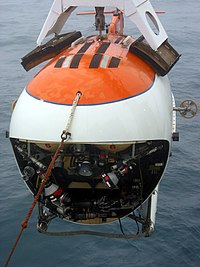Mir (submersible)
 |
|
| History | |
|---|---|
|
|
|
| Name: | Mir |
| Builder: | Rauma-Repola Oceanics / Lokomo |
| Completed: | 1987 |
| In service: | 1987 |
| General characteristics | |
| Type: | Deep-submergence vehicle |
| Displacement: | 18.6 tons |
| Length: | 7.8 m (26 ft) |
| Beam: | 3.6 m (12 ft) |
| Draft: | 3.0 m (9.8 ft) |
| Installed power: | 9kW electric motor |
| Speed: | 5kn |
| Test depth: | 6,000 m (20,000 ft) |
| Complement: | 3 |
Mir (Russian: "Мир", world or peace) is a self-propelled Deep Submergence Vehicle. The project was initially developed by the USSR Academy of Sciences (now the Russian Academy of Sciences) along with Design Bureau Lazurith. Later two vehicles were ordered from Finland. The Mir 1 and Mir 2, delivered in 1987, were designed and built by the Finnish company Rauma-Repola's Oceanics subsidiary. The project was carried out under the supervision of constructors and engineers of the Shirshov Institute of Oceanology.
The vessels are designed to be used for scientific research. They might also be used to assist in submarine rescue operations, although they do not have the capacity to take anybody aboard when underwater. The carrier and command centre of both Mir submersibles is the R/V Akademik Mstislav Keldysh. The two Mir units are operated by the Russian Academy of Sciences.
The Mir submersibles can dive to a maximum depth of 6,000 metres (19,685 ft).
Traditionally, the personnel sphere of a deep sea submersible is manufactured of titanium plates that are welded together. On Mir, the personnel sphere is made of a maraging steel alloy that has ten percent better strength/weight ratio than titanium. This alloy contains about 30% cobalt and smaller amounts of nickel, chrome and titanium. Two hemispheres were made by casting and machining, and then bolted together, thus avoiding welded joints. The resulting construction is close to the density of water, thus making it easier to move in different depths. Additional buoyancy is provided by 8 cubic metres (280 cu ft) of syntactic foam. Unlike other Deep Submergence Vehicles that use iron ballast to reach the ocean floor, the buoyancy and depth is adjusted by ballast tanks.
...
Wikipedia
